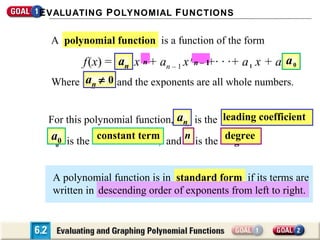
Evaluating and Graphing Polynomial Functions
- 1. E VALUATING P OLYNOMIAL F UNCTIONS A polynomial function is a function of the form f (x) = an x nn + an – 1 x nn––1 1 · ·+ a 1 x + a 0 a 0 +· n 0 Where an ≠ 0 and the exponents are all whole numbers. n For this polynomial function, an is the an constant term a a 00 is the constant term, and n is the n leading coefficient leading coefficient, degree degree. A polynomial function is in standard form if its terms are descending order of exponents from left to right. written in descending order of exponents from left to right.
- 2. E VALUATING P OLYNOMIAL F UNCTIONS You are already familiar with some types of polynomial functions. Here is a summary of common types of polynomial functions. Degree Type Standard Form 0 Constant f (x) = a 0 1 Linear f (x) = a1x + a 0 2 Quadratic f (x) = a 2 x 2 + a 1 x + a 0 3 Cubic f (x) = a 3 x 3 + a 2 x 2 + a 1 x + a 0 4 Quartic f (x) = a4 x 4 + a 3 x 3 + a 2 x 2 + a 1 x + a 0
- 3. Identifying Polynomial Functions Decide whether the function is a polynomial function. If it is, write the function in standard form and state its degree, type and leading coefficient. f (x) = 1 2 x – 3x4 – 7 2 S OLUTION The function is a polynomial function. Its standard form is f (x) = – 3x 4 + 1 2 x – 7. 2 It has degree 4, so it is a quartic function. The leading coefficient is – 3.
- 4. Identifying Polynomial Functions Decide whether the function is a polynomial function. If it is, write the function in standard form and state its degree, type and leading coefficient. f (x) = x 3 + 3 x S OLUTION The function is not a polynomial function because the x term 3 does not have a variable base and an exponent that is a whole number.
- 5. Identifying Polynomial Functions Decide whether the function is a polynomial function. If it is, write the function in standard form and state its degree, type and leading coefficient. – f (x) = 6x 2 + 2 x 1 + x S OLUTION The function is not a polynomial function because the term 2x –1 has an exponent that is not a whole number.
- 6. Identifying Polynomial Functions Decide whether the function is a polynomial function. If it is, write the function in standard form and state its degree, type and leading coefficient. f (x) = – 0.5 x + π x 2 – 2 S OLUTION The function is a polynomial function. Its standard form is f (x) = π x2 – 0.5x – 2. It has degree 2, so it is a quadratic function. The leading coefficient is π.
- 7. Identifying Polynomial Functions Polynomial function? f (x) = 1 x 2 – 3 x 4 – 7 2 f (x) = x 3 + 3x f (x) = 6x2 + 2 x– 1 + x f (x) = – 0.5x + π x2 – 2
- 8. Using Synthetic Substitution One way to evaluate polynomial functions is to use direct substitution. Another way to evaluate a polynomial is to use synthetic substitution. Use synthetic division to evaluate f (x) = 2 x 4 + −8 x 2 + 5 x − 7 when x = 3.
- 9. Using Synthetic Substitution S OLUTION 2 x 4 + 0 x 3 + (–8 x 2) + 5 x + (–7) Polynomial Polynomial inin standard form standard form 3• 3 2 0 –8 5 –7 Coefficients 6 18 30 105 6 10 35 98 x-value 2 The value of (3) is the last number you write, The value of ff(3) is the last number you write, In the bottom right-hand corner. In the bottom right-hand corner.
- 10. G RAPHING P OLYNOMIAL F UNCTIONS The end behavior of a polynomial function’s graph is the behavior of the graph as x approaches infinity (+ ∞) or negative infinity (– ∞). The expression x + ∞ is read as “x approaches positive infinity.”
- 11. G RAPHING P OLYNOMIAL F UNCTIONS END BEHAVIOR
- 12. G RAPHING P OLYNOMIAL F UNCTIONS C ONCEPT END BEHAVIOR FOR POLYNOMIAL FUNCTIONS S UMMARY x +∞ +∞ f (x) +∞ f (x) –∞ f (x) +∞ even f (x) –∞ f (x) –∞ odd f (x) +∞ f (x) –∞ an n x >0 even f (x) >0 odd <0 <0 –∞
- 13. Graphing Polynomial Functions Graph f (x) = x 3 + x 2 – 4 x – 1. S OLUTION To graph the function, make a table of values and plot the corresponding points. Connect the points with a smooth curve and check the end behavior. x –3 –2 –1 0 1 2 The degree is odd and the leading coefficient is positive, 3 –3 as3x 23 + + (x) so f (x)f(x) – –7 as x 3 – 3 and f–1 .
- 14. Graphing Polynomial Functions Graph f (x) = –x 4 – 2x 3 + 2x 2 + 4x. S OLUTION To graph the function, make a table of values and plot the corresponding points. Connect the points with a smooth curve and check the end behavior. x 0 1 2 3 The degree –3even–2 the leading coefficient is negative, is and –1 f (x) – –21 as x 0 0 ––1 and f (x) 3 – –16 x –105 + as so f (x) .
- 15. Assignment